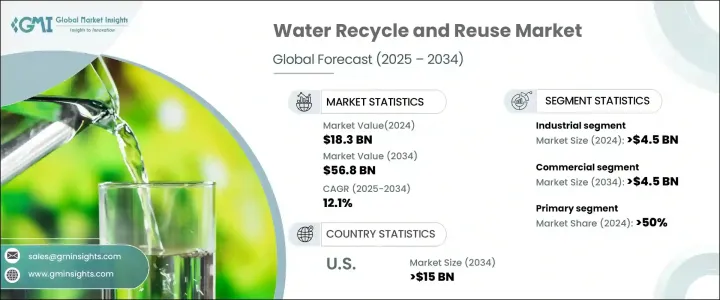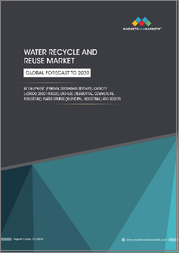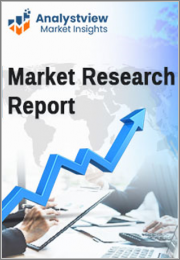
|
시장보고서
상품코드
1698525
물 재활용 및 재이용 시장 기회, 성장 촉진요인, 산업 동향 분석, 예측(2025-2034년)Water Recycle and Reuse Market Opportunity, Growth Drivers, Industry Trend Analysis, and Forecast 2025-2034 |
||||||
세계 물 재활용 및 재이용 시장은 2024년 183억 달러로 평가되며 2025년부터 2034년까지 CAGR 12.1%로 성장할 것으로 예상됩니다.
급격한 인구 증가, 기후 변화, 도시화에 따른 담수 수요 증가로 인해 산업계, 지자체, 농업 부문은 물 재활용 솔루션에 대한 투자를 늘리고 있습니다. 세계 각국 정부는 엄격한 물 절약 정책을 시행하고 첨단 재생 및 처리 기술을 촉진하여 시장 성장을 강화하고 있습니다.

막분리 활성오니법, 자외선 소독법, 여과법, 역삼투압법 등의 지속적인 발전으로 물 재활용 시스템의 비용 효율성과 효율성이 향상되어 수요를 더욱 자극하고 있습니다. 천연 수자원에 대한 의존도를 줄이기 위해 지속가능한 물 솔루션으로의 전환이 진행되고 있는 것도 시장 확대에 기여하고 있습니다. 식음료 가공, 석유 및 가스, 발전, 제조 등 업무 효율을 유지하기 위해 대량의 물이 필요한 산업은 시장 개척의 주요 촉진요인으로 작용하고 있습니다.
| 시장 범위 | |
|---|---|
| 시작 연도 | 2024년 |
| 예측 연도 | 2025-2034년 |
| 시작 금액 | 183억 달러 |
| 예상 금액 | 568억 달러 |
| CAGR | 12.1% |
시장은 기술별로 1차, 2차, 3차 처리 시스템으로 구분됩니다. 1차 처리 분야는 2024년 매출의 50% 이상을 차지했으며, 규제 대응과 세계 물 부족에 힘입어 성장세를 이어갈 것으로 보입니다. 환경 기준을 충족하고 자원 효율을 높이기 위한 산업계의 해수 담수화 및 무방류 솔루션 채택이 시장 침투의 원동력이 되고 있습니다.
산업 분야는 2024년 45억 달러, 2034년에는 150억 달러를 넘어섰으며, 기업들은 지자체 물 공급에 대한 의존도를 낮추기 위해 모듈식 및 확장 가능한 현장 재활용 시스템에 집중하고 있습니다. 제약, 식품 가공, 석유화학, 반도체 산업은 안정적인 수질과 고순도의 물을 필요로 하며, 이는 시장 역학에 영향을 미치는 주요 요인으로 작용하고 있습니다. 2024년 35억 달러 규모의 농업 분야는 기후 변화, 지하수 고갈, 예측 불가능한 강우 패턴으로 인해 물 재활용 솔루션의 채택이 증가하고 있습니다. 여과, UV 소독, 역삼투압과 같은 기술은 안전하고 효과적인 농업 폐수 재사용을 가능하게 합니다.
주택 부문은 2024년 14%의 매출 점유율을 차지했으며, 주택 소유주들은 폐기물을 최소화하고 일상적인 물 공급을 최적화하기 위해 물 재이용 기술에 투자하고 있습니다. 세탁, 샤워, 빗물 재사용 등 비식용수 용도의 재활용 시스템이 인기를 끌고 있습니다. 병원, 쇼핑센터, 호텔, 오피스 빌딩, 기타 상업 시설에서 물 재이용 시스템 도입이 진행됨에 따라 상업 분야는 2034년까지 45억 달러를 넘어설 것으로 예상됩니다. 정부의 인센티브, 세제 혜택, 연방 정부의 보조금이 이러한 추세를 더욱 부추기고 있습니다.
도시화와 엄격한 폐수 규제로 인해 하수 처리 및 물 조달 기술의 도입이 촉진되고 있습니다. 각 도시는 운영 비용을 절감하고 인프라를 강화하기 위해 이러한 솔루션을 통합하고 있습니다. 미국 시장은 2024년 69억 달러로 평가되며, 2034년에는 물 부족, 인프라 문제, 기후 관련 문제를 해결하기 위한 지속가능한 솔루션을 모색하는 도시와 산업계로 인해 150억 달러를 넘어설 것으로 예상됩니다. 이 지역은 지하수에 의존하고 있으며, 가뭄이 장기화되면서 재생수 플랜트 도입에 박차를 가하고 있습니다.
북미는 ESG 전략, 물 절약, 고도 여과 기술에 대한 관심이 높아지면서 2034년까지 연평균 10% 이상의 성장이 예상됩니다. 각국 정부는 지속가능한 물 재이용 솔루션을 촉진하기 위해 인센티브를 제공하고, 연구 개발 이니셔티브에 자금을 지원하여 전체 시장의 모멘텀을 촉진하고 있습니다.
목차
제1장 조사 방법과 조사 범위
- 시장 범위와 정의
- 시장 추정과 예측 파라미터
- 예측 계산
- 데이터 소스
- 1차
- 2차
- 유료
- 공적
제2장 주요 요약
제3장 업계 인사이트
- 업계 생태계 분석
- 규제 상황
- 업계에 대한 영향요인
- 성장 촉진요인
- 업계의 잠재적 리스크·과제
- 성장 가능성 분석
- Porters 분석
- PESTEL 분석
제4장 경쟁 구도
- 소개
- 전략적 전망
- 혁신과 지속가능성 전망
제5장 시장 규모 및 예측 : 기술별, 2021-2034년
- 주요 동향
- 1차
- 정밀여과(MF)
- 한외여과(UF)
- 나노여과(NF)
- 역삼투(RO)
- 탈염
- 2차
- 고도 산화 프로세스(AOP)
- 소독
- 화학 응집·응집
- 막분리 활성슬러지법(MBR)
- 입상 활성탄(GAC) 여과
- 이온 교환
- 생물학적 치료
- 3차 처리
제6장 시장 규모 및 예측 : 용도별, 2021-2034년
- 주요 동향
- 산업
- 농업
- 주택
- 상업
- 자치체
제7장 시장 규모 및 예측 : 지역별, 2021-2034년
- 주요 동향
- 북미
- 미국
- 캐나다
- 유럽
- 영국
- 독일
- 프랑스
- 이탈리아
- 스페인
- 아시아태평양
- 중국
- 인도
- 일본
- 한국
- 싱가포르
- 중동 및 아프리카
- UAE
- 사우디아라비아
- 남아프리카공화국
- 라틴아메리카
- 브라질
- 멕시코
제8장 기업 개요
- 3M
- ABB
- American Water
- Aquatech
- BASF
- Dow
- Ecolab
- Hitachi
- Kurita Water Industries
- MANN+HUMMEL
- OVIVO
- Pentair
- Siemens
- SUEZ
- Triveni Engineering &Industries
- Trojan Technologies Group
- Veolia
- Xylem
The Global Water Recycle And Reuse Market was valued at USD 18.3 billion in 2024 and is projected to grow at a CAGR of 12.1% from 2025 to 2034. Rising demand for freshwater, driven by rapid population growth, climate change, and urbanization, is pushing industries, municipalities, and the agricultural sector to invest in water recycling solutions. Governments worldwide are enforcing strict water conservation policies and promoting advanced reclamation and treatment technologies, strengthening market growth.

Ongoing advancements in membrane bioreactors, ultraviolet disinfection, filtration, and reverse osmosis are making water recycling systems more cost-effective and efficient, further stimulating demand. The increasing shift toward sustainable water solutions to reduce dependence on natural water sources is also contributing to market expansion. Industries such as food and beverage processing, oil and gas, power generation, and manufacturing, which require large volumes of water to maintain operational efficiency, are key drivers of market development.
| Market Scope | |
|---|---|
| Start Year | 2024 |
| Forecast Year | 2025-2034 |
| Start Value | $18.3 Billion |
| Forecast Value | $56.8 Billion |
| CAGR | 12.1% |
The market is segmented by technology into primary, secondary, and tertiary treatment systems. The primary segment accounted for over 50% of revenue in 2024, supported by regulatory compliance and increasing global water stress. The adoption of desalination and zero-liquid discharge solutions by industries aiming to meet environmental standards and improve resource efficiency is driving market penetration.
The industrial sector reached USD 4.5 billion in 2024 and is projected to exceed USD 15 billion by 2034, with companies focusing on modular and scalable on-site recycling systems to reduce reliance on municipal water supplies. The need for consistent water quality and high-purity water in pharmaceutical, food processing, petrochemical, and semiconductor industries is a key factor influencing market dynamics. The agricultural sector, valued at USD 3.5 billion in 2024, is experiencing increased adoption of water recycling solutions due to climate change, groundwater depletion, and unpredictable rainfall patterns. Technologies such as filtration, UV disinfection, and reverse osmosis are ensuring safe and effective agricultural wastewater reuse.
The residential segment held a 14% revenue share in 2024, with homeowners investing in water reuse technologies to minimize waste and optimize water supply for daily use. Recycling systems for non-potable applications, including laundry, showers, and rainwater reuse, are gaining popularity. The commercial segment is set to exceed USD 4.5 billion by 2034, as water reuse systems are increasingly implemented in hospitals, shopping centers, hotels, office buildings, and other commercial establishments. Government incentives, tax benefits, and federal grants are further supporting this trend.
Municipal water recycling held a 28.9% market share in 2024, with urbanization and stringent wastewater regulations promoting the adoption of sewage treatment and water procurement technologies. Cities are integrating these solutions to reduce operational costs and enhance infrastructure. The U.S. market was valued at USD 6.9 billion in 2024 and is anticipated to surpass USD 15 billion by 2034, as municipalities and industries seek sustainable solutions to address water scarcity, infrastructure challenges, and climate-related concerns. The region's dependence on groundwater and prolonged droughts are fueling the adoption of recycled water plants.
North America is expected to grow at a CAGR of over 10% through 2034, with increasing emphasis on ESG strategies, water conservation, and advanced filtration technologies. Governments are offering incentives and funding R&D initiatives to promote sustainable water reuse solutions, driving overall market momentum.
Table of Contents
Chapter 1 Methodology & Scope
- 1.1 Market scope & definitions
- 1.2 Market estimates & forecast parameters
- 1.3 Forecast calculation
- 1.4 Data sources
- 1.4.1 Primary
- 1.4.2 Secondary
- 1.4.2.1 Paid
- 1.4.2.2 Public
Chapter 2 Executive Summary
- 2.1 Industry synopsis, 2021 - 2034
Chapter 3 Industry Insights
- 3.1 Industry ecosystem analysis
- 3.2 Regulatory landscape
- 3.3 Industry impact forces
- 3.3.1 Growth drivers
- 3.3.2 Industry pitfalls & challenges
- 3.4 Growth potential analysis
- 3.5 Porter's analysis
- 3.5.1 Bargaining power of suppliers
- 3.5.2 Bargaining power of buyers
- 3.5.3 Threat of new entrants
- 3.5.4 Threat of substitutes
- 3.6 PESTEL analysis
Chapter 4 Competitive Landscape, 2025
- 4.1 Introduction
- 4.2 Strategic outlook
- 4.3 Innovation & sustainability landscape
Chapter 5 Market Size and Forecast, By Technology, 2021 – 2034 (USD Million)
- 5.1 Key trends
- 5.2 Primary
- 5.2.1 Microfiltration (MF)
- 5.2.2 Ultrafiltration (UF)
- 5.2.3 Nanofiltration (NF)
- 5.2.4 Reverse Osmosis (RO)
- 5.2.5 Desalination
- 5.3 Secondary
- 5.3.1 Advanced Oxidation Processes (AOP)
- 5.3.2 Disinfection
- 5.3.3 Chemical coagulation and flocculation
- 5.3.4 Membrane Bioreactors (MBRs)
- 5.3.5 Granular Activated Carbon (GAC) filtration
- 5.3.6 Ion exchange
- 5.3.7 Biological treatment
- 5.4 Tertiary
Chapter 6 Market Size and Forecast, By Application, 2021 – 2034 (USD Million)
- 6.1 Key trends
- 6.2 Industrial
- 6.3 Agriculture
- 6.4 Residential
- 6.5 Commercial
- 6.6 Municipal
Chapter 7 Market Size and Forecast, By Region, 2021 – 2034 (USD Million)
- 7.1 Key trends
- 7.2 North America
- 7.2.1 U.S.
- 7.2.2 Canada
- 7.3 Europe
- 7.3.1 UK
- 7.3.2 Germany
- 7.3.3 France
- 7.3.4 Italy
- 7.3.5 Spain
- 7.4 Asia Pacific
- 7.4.1 China
- 7.4.2 India
- 7.4.3 Japan
- 7.4.4 South Korea
- 7.4.5 Singapore
- 7.5 Middle East & Africa
- 7.5.1 UAE
- 7.5.2 Saudi Arabia
- 7.5.3 South Africa
- 7.6 Latin America
- 7.6.1 Brazil
- 7.6.2 Mexico
Chapter 8 Company Profiles
- 8.1 3M
- 8.2 ABB
- 8.3 American Water
- 8.4 Aquatech
- 8.5 BASF
- 8.6 Dow
- 8.7 Ecolab
- 8.8 Hitachi
- 8.9 Kurita Water Industries
- 8.10 MANN+HUMMEL
- 8.11 OVIVO
- 8.12 Pentair
- 8.13 Siemens
- 8.14 SUEZ
- 8.15 Triveni Engineering & Industries
- 8.16 Trojan Technologies Group
- 8.17 Veolia
- 8.18 Xylem














